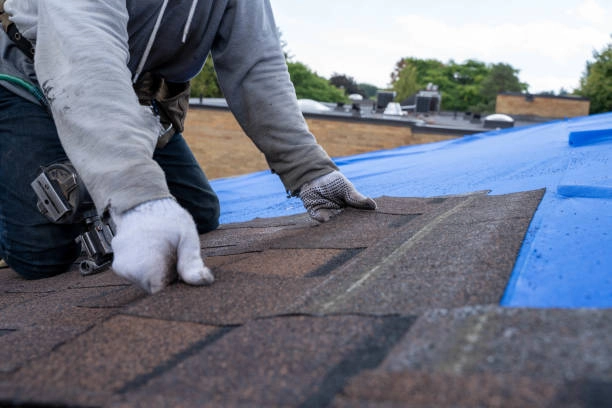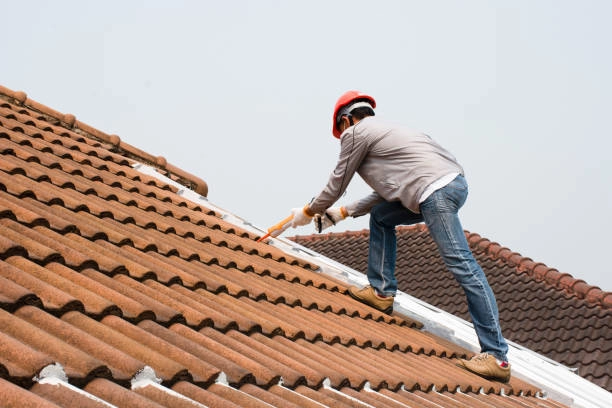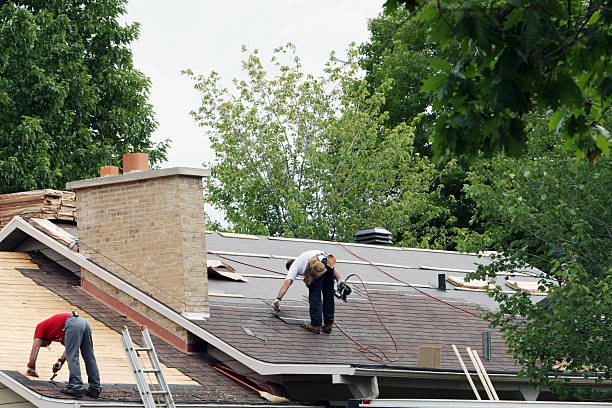When ensuring your home remains stylish and steadfast against the whims of weather, few decisions are as critical as selecting the ideal roofing material. This choice impacts your home’s curb appeal and its ability to withstand the elements, its thermal efficiency, and even its resale value. Understanding the importance of this decision, this guide aims to shed light on various roofing options. Whether you’re working with a roofing contractor for a new roof installation or discussing roof replacement options, the goal is to arm you with the information needed to make a choice that aligns with your aesthetic preferences and functional needs.
The Aesthetic Appeal: Finding Your Home’s Perfect Match
Your home’s roof does more than just protect you from the rain and sun; it’s a statement piece that caps off your home’s design. Working with a seasoned roofer or roofing company can help you navigate the vast array of materials available, ensuring your final choice complements your home’s architectural style. Here are a few examples of how certain materials pair beautifully with different home designs:
- Asphalt Shingles: Versatile and cost-effective, asphalt shingles work well with virtually any home style, from modern to traditional. They’re particularly popular for their wide range of colors and textures.
- Metal Roofing: Ideal for homes with a contemporary or industrial aesthetic, metal roofs offer longevity and energy efficiency. Due to their fire resistance, they’re also suitable for houses in wildfire-prone areas.
- Clay Tiles: Often seen on Mediterranean, Spanish, and Southwestern-style homes, clay tiles add a touch of elegance and durability, known for their longevity and natural ability to reflect sunlight.
- Slate: Perfect for Colonial, European, and Chateau-inspired homes, slate roofing is the epitome of sophistication and durability. It’s a premium choice that can last over a century with proper maintenance.

Durability in the Face of Nature: Which Roof Stands Tall?
A roof’s ability to withstand nature’s elements is paramount. When considering a roof installation, evaluating the material’s durability against sun exposure, rain, wind, and snow is essential. Additionally, consider the warranty offered by the roofing company or roofing contractor as a testament to the material’s longevity. Here’s a quick comparison:
Asphalt Shingles
- Lifespan: 20-30 years
- Good resistance to varied weather conditions
- Warranty: Varies, with some options up to a 25-year warranty
Metal Roofing
- Lifespan: 40-70 years
- Excellent resistance to extreme weather, including high winds and hail
- Warranty: Often comes with a 30 to 50-year warranty
Clay Tiles
- Lifespan: 50-100 years
- Great for hot climates, resistant to decay and insects
- Warranty: Can extend up to a 30-year warranty
Slate Tiles
- Lifespan: 100+ years
- Highly durable against severe weather conditions
- Warranty: Limited offerings, due to its natural longevity
When choosing a roofing material, involve a professional roofer or roofing contractor in the decision-making process. Their expertise can guide you in selecting a material that not only meets your aesthetic preferences but also withstands the challenges posed by your local climate.
This comparative guide is designed to navigate the complexities of roof replacement and installation. Stay tuned as we explore more factors that will help you choose the perfect roofing material for your home.
Weighing the Costs: Initial Investment vs. Long-term Value
Choosing a roofing material involves more than just paying for the product itself; it also includes considering roof installation costs, maintenance, and potential energy savings. Here’s a closer look:
- Initial Costs: Asphalt shingles often have the lowest upfront cost, while materials like slate and metal come with a higher initial price tag. However, the durability and lifespan of the material can offset these costs over time.
- Maintenance Expenses: Materials like metal and slate require minimal maintenance, while asphalt shingles may need more frequent repairs or replacement.
- Energy Savings: Certain materials, such as metal roofing, can reflect sunlight and reduce cooling costs in the summer. The initial investment in such materials can lead to significant savings on energy bills.
- Return on Investment (ROI): Premium materials like slate and metal may have a higher upfront cost but often offer a higher ROI through increased property value, reduced maintenance costs, and energy efficiency.

Eco-Friendly Options: Green Roofing for a Sustainable Future
As environmental concerns become a priority for many homeowners, eco-friendly roofing options are gaining popularity. Here are some sustainable choices:
- Recycled Shingles: Made from recycled materials, these shingles are an environmentally friendly choice that doesn’t sacrifice durability.
- Green Roofs: These living roofs, covered with vegetation, help insulate the home, manage stormwater, and reduce heat islands.
- Solar Tiles: Integrating solar technology into roofing materials offers a way to generate renewable energy while maintaining aesthetic appeal.
Benefits for the Environment
Sustainable roofing options can reduce landfill waste, lower energy consumption, and promote a healthier local ecosystem. Additionally, homeowners might benefit from local incentives for choosing green roofing solutions.
Roof Installation and Maintenance: Ensuring Durability and Longevity
The journey to a lasting roof doesn’t end with selecting the right material; understanding the nuances of roof installation and ongoing maintenance is equally important. Let’s delve into how different roofing materials fare in these aspects and offer some tips to maximize their lifespan.
Roofing Installation Considerations
- Expertise Required: Materials like clay tiles and slate require specialized skills for roof installation, making it crucial to hire an experienced roofer or roofing contractor who can ensure the job is done correctly.
- Time and Labor: The complexity of roof installation varies by material. Asphalt shingles are relatively quick and easy to install, which can reduce labor costs. In contrast, metal roofs and tiles may require more time and expertise, potentially increasing the roof installation cost.
Maintenance Needs and Tips
Each roofing material comes with its own set of maintenance requirements. Regular care can prevent minor issues from escalating into costly repairs:
- Asphalt Shingles: Inspect for and replace damaged or missing shingles promptly to avoid leaks. Keep the roof free of moss and debris.
- Metal Roofing: Though low-maintenance, it’s wise to check for scratches or dents and apply a protective coating as needed to prevent rust.
- Clay Tiles: Cracked or broken tiles should be replaced by a professional to maintain the roof’s integrity and prevent water damage.
- Slate Roofing: While exceptionally durable, slate can be brittle. Avoid walking on the roof, and have a specialist inspect and replace damaged tiles to preserve their longevity.
- Green Roofs: Require regular weeding and watering to ensure the vegetation remains healthy and effective in its insulation and water management roles.
Longevity Tips
- Regular Inspections: Engage a professional roofing company or contractor for annual roof inspections to identify and address potential issues early.
- Gutter Maintenance: Keep gutters and downspouts clear to prevent water buildup and damage.
- Ventilation: Ensure your attic is well-ventilated to prevent heat and moisture buildup, which can prematurely age your roof.
- Immediate Roof Repairs: Addressing repairs promptly can prevent minor issues from becoming major problems, extending the life of your roof.
Proper roof installation and diligent maintenance are key to maximizing the life of your roof. By choosing a qualified roofer and adhering to these care tips, you can ensure that your roof remains a strong, beautiful, and efficient protector of your home for years to come.

Climate Considerations: Finding Your Weather Warrior
The local climate plays a significant role in determining the most suitable roofing material for your home. Each material offers unique benefits and challenges in different environmental conditions:
- Hot Climates: Light-colored metal roofs reflect sunlight, reducing cooling costs. Clay tiles also perform well in heat, offering natural insulation.
- Cold Environments: Slate and asphalt shingles are effective in colder climates, offering excellent insulation and resistance to snow and ice.
- Wet Regions: Rubber roofing and treated wood shakes provide strong resistance to moisture and mold.
- Windy Areas: Metal roofs and heavier materials like slate can withstand high winds better than lighter options.
Choosing a material that aligns with your local weather conditions ensures that your roof remains a protective and efficient element of your home.
Safety First: Fire Resistance and Weight Factors
When selecting a roofing material, considering its fire resistance and the structural weight your home can support is crucial for safety and compliance:
- Fire Resistance Ratings: Materials like metal, clay tiles, and slate have high fire resistance ratings, offering greater protection against fire hazards. In contrast, wood shingles may require additional treatment to improve fire resistance.
- Structural Weight: Slate and clay tiles are heavier and may require additional structural support. Before selecting a heavier material, consult a structural engineer or a knowledgeable roofing contractor to ensure your home can safely support the weight.
In Conclusion: Your Roof, Your Choice
Selecting the right roofing material involves balancing aesthetics, durability, cost, environmental impact, roof installation and maintenance requirements, climate considerations, and safety factors. Here’s a recap of the key points to guide your decision:
- Aesthetic Appeal: Match the material to your home’s architectural style.
- Durability and Maintenance: Choose a material that suits your local climate while considering long-term maintenance needs.
- Costs and Value: Evaluate the initial investment against the long-term benefits, including energy savings and ROI.
- Eco-Friendly Options: Consider sustainable materials for environmental benefits and potential incentives.
- Climate and Safety Considerations: Select materials that perform well in your local weather and meet safety requirements.
While personal preferences and budget are paramount, consulting with a professional roofer can provide tailored recommendations that align with your needs. A knowledgeable roofing contractor will help navigate the complexities of roof replacement or installation, ensuring that your final choice not only enhances the beauty of your home but also its protection and efficiency for years to come.

Roof Installation in Bloomington, Minnesota
Twin Cities Contracting Services Inc. specializes in transforming homes in Bloomington with top-tier roof installations. Our expertise covers a wide range of materials, from durable shingle roofs to ensure your home stands tall against Minnesota’s unique climate challenges. With an eye for aesthetic appeal and a commitment to using eco-friendly options, our team delivers solutions that are not just about protection but also about enhancing your home’s energy efficiency and curb appeal.
Trust us to navigate the complexities of roof installation and maintenance, ensuring a seamless process from start to finish. Twin Cities Contracting Services Inc. is your go-to roofing contractor for a roofing experience that combines the best in durability, style, and sustainable practices. Your roof is your home’s first line of defense; let’s make it the best. Call us today at (952) 405-6201.
Read more

